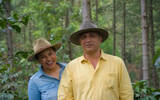A 10-year record high! Arabica coffee beans cost 273.4 cents/pound
By the close of trading this afternoon, the price benchmark of the coffee bean industry, American Type C coffee futures, closed at 270.40 cents per pound, peaking at 273.4 cents per pound, the highest level in 10 years.
According to media reports, coffee prices have risen due to various climatic factors in Brazil, as well as climate challenges faced by other major coffee-producing countries, as well as increased global demand for coffee. Robusta, in particular, was priced at 1483.95 reais per bag in August, double that of the same period last year. And exceed the price of Arabica in Brazil.
So far this year, the price of robusta coffee has risen 74%, and the price of Arabica coffee has risen by 40%. At present, the price of coffee futures is also hitting a new high, with Robusta futures reaching 5483 US dollars per ton and Arabica futures reaching 273.4 cents per pound.
According to Brazilian media reports, Brazil is about to usher in the seventh heat wave this year, and the heat wave will cause some cities in the central, western and southeastern parts of Brazil to break the high temperature record. Data from Brazil's National Weather Service (Inmet) show that the worst affected areas include Brazil's Rio Grande do Sul, Santa Catarina, Parana, Sao Paulo and Minas Gerais.
According to records, the highest temperature so far this year will be recorded in the state of Sao Paulo, and the highest climate may once again exceed 35 °C. The highest temperature in Rio de Janeiro reached 39.5 °C in January, and the temperature is likely to be close to this level, reaching 39 °C. The highest temperature in Minas Gerais is likely to break the previous record of more than 34 °C. Temperatures in these areas are above average by 5 °C.
Moreover, because the hot air mass has been in the central and western part of Brazil, hindering Rain Water's movement inland, rainfall is now concentrated in the southern state of Rio Grande do Sul, where rainfall now reaches 100mm per day. The risk of flooding rivers and landslides is higher. And the cold air is also blocked by hot air masses, staying in Rio Grande do Sul, causing hail.
As Brazil has been affected by a variety of bad weather in recent years, it has experienced drought and high temperatures this year, resulting in a decline in Brazilian coffee production, making Brazilian coffee an increasingly expensive commodity. According to Brazil's national consumer price index (IPCA), the price of coffee purchased by domestic consumption in Brazil rose 16.6 per cent, much higher than the overall inflation rate of 4.2 per cent.
In August this year, the average price per kilogram of coffee in the retail market reached 39.63 reais, the highest since the Brazilian Coffee Industry Association (Abic) began recording it in 1997. According to the Brazilian Coffee Industry Association, the price of coffee in January 2021 was 15.37 reais / kg, while the current average price has reached 39.63 reais / kg, an increase of 157% in three and a half years.
According to the president of the Brazilian Coffee Industry Association, coffee production in Brazil reached a record of 63.07 million bags (60 kg / bag) in 2020, breaking an all-time high, but in 2021, many coffee plantations were severely damaged by frost. the subsequent drought and hot weather continued to affect coffee cultivation, resulting in no record of production close to 2020.
It is understood that Brazilian coffee has a biennial cycle, the yield of high and low alternating (positive cycle and negative cycle), but in recent years, production fluctuations have broken this rule. It was supposed to be a positive anniversary in 2024, but Conab's latest forecast for coffee production in September was 54.79 million bags, down 0.5 per cent from last year's negative cycle and 6.8 per cent from 58.81 million bags in May. Conab believes that the decline in yield is due to drought, uneven distribution of rainfall and high temperature during fruit development.
Researchers at the Advanced Applied Economics Research Centre (Cepea) at the University of Sao Paulo said that the harvest of coffee in the next new season is not optimistic, as Brazil should enter the spring and rainy season in September, but so far, there has been no rain in Brazilian coffee producing areas, and some areas have not had a drop of rain for more than 160 days, which is very bad for the plantations in the region. According to Brazilian meteorologists, high temperatures will continue even in spring, and a new heat wave may occur in early October, but the rainfall will gradually return, extending from the south to the Midwest in November and covering northern Brazil only in December.
Many traders think that the current prices are rising too fast, and there is little room for decline. In the past, traders would buy and hoard coffee beans when prices were low, but after a year of price increases, enterprises with stocks continue to sell. As a result, there is no stock now. Coupled with the continuous decline in production, prices will only continue to rise and it will be difficult to fall back. Many traders think that this is disadvantageous to the industry as a whole. Although the coffee in the hands of producers is more valuable, there are still goods to sell at a lower price. Now that the price is rising to high, there is no point in selling without goods in hand.
For more information about coffee producing areas, please scan the code directly and follow: coffee comments.
Long press the QR code to follow:
TRANSLATE with
XEnglishArabicHebrewPolishBulgarianHindiPortugueseCatalanHmong DawRomanianChinese SimplifiedHungarianRussianChinese TraditionalIndonesianSlovakCzechItalianSlovenianDanishJapaneseSpanishDutchKlingonSwedishEnglishKoreanThaiEstonianLatvianTurkishFinnishLithuanianUkrainianFrenchMalayUrduGermanMalteseVietnameseGreekNorwegianWelshHaitian CreolePersian
TRANSLATE with
COPY THE URL BELOW
BackEMBED THE SNIPPET BELOW IN YOUR SITE Bing Webmaster PortalBack
Important Notice :
前街咖啡 FrontStreet Coffee has moved to new addredd:
FrontStreet Coffee Address: 315,Donghua East Road,GuangZhou
Tel:020 38364473
- Prev

Long-term stay by customers has led to successive bankruptcies of coffee shops!
▲ Click to pay attention| Daily Boutique Coffee Culture Magazine Coffee Workshop Recently, Japanese media "Aeradot" reported that many coffee shops closed down one after another due to a large number of customers ordering only one cup of coffee but staying for a long time. This phenomenon has attracted widespread attention in society. The report pointed out that with the popularity of telecommuting,
- Next

What are the flavor characteristics of Honduran coffee? What areas are coffee mainly grown?
Thanks to Central America's rich terrain, diverse climates, forests and mountains, and volcanic belts of more than 1300 kilometers long, Central American coffee has become a place in the global market. But when it comes to Central American coffee, most people think of Costa Rica and Panama. But in recent years, Honduras has become the most important thing in China and the United States.
Related
- Customers have "changed" Manner's new products! Shop assistant: Please don't mess around!
- Remove sockets in customer areas at Starbucks stores?! Netizen: I won't go if I really tear it down
- What is the difference between the taste steps of sun-dried coffee and washed coffee? Why is sun-cured coffee sweeter and washed coffee sour?
- The recipe for salty grapefruit dirty is revealed! Coffee Festival salty grapefruit dirty coffee making materials parameters ratio milk share!
- How about the flavor of Sunlight 74158 at Sidamo Banshaha Mathieu Processing Factory in Ethiopia? 74158 Share the proportion of coffee brewing parameters!
- What effect does Italian American coffee with filter paper have? Will coffee taste better if it is put on filter paper at the bottom of the powder bowl?
- What is the color difference in coffee beans? What are the characteristics of honey processed coffee beans? Why are the anaerobically treated coffee beans uneven in color?
- How does novice Xiaobai quickly get started and make coffee? Newbies learn to make coffee by hand and share the specific steps and process process!
- Costa tea has a shelf life of 100 years?! Expert: Unable to verify
- It's a huge uproar! American milk addition was rejected by Manner employees?!

